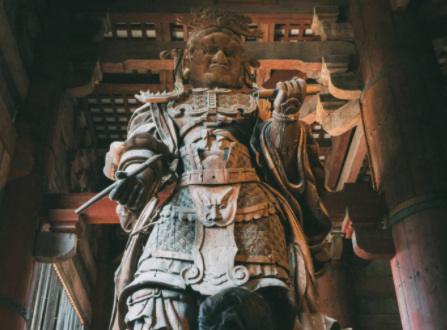Bishamonten is the Japanese version of the Buddhist protector deity Vaisravana, who in Japan is typically shown wielding a large axe or club. The character appears in various stories and is said to enforce Buddhist law and order.
The most famous stories about Bishamonten involve him killing a thousand children with his spear, which he then magically transforms into a pagoda. According to the legend, many people believe that when they die, their souls will go to Bishamonten’s treasure house in the sky. The name of this god is composed of two Chinese characters meaning “warrior” (武) and “ten thousand” (千).
- What is Bishamonten?
- When and where was this god created?
- What does Bishamonten do for people?
- Who is Bishamonten’s family and does he have any enemies?
- Why is he portrayed with an axe?
- Who was Bishamonten’s wife?
- Who or what does Bishamonten guard?
- How do people believe Bishamonten destroys evil spirits and gives them the opportunity to rehabilitate themselves?
Who is Bishamonten?
He is the Japanese version of Bishamon, who is thought to be an armored god of war. He is the son of Vajrapani, one of the four Heavenly Kings, and his wife Boddhisatva. He is said to enforce Buddhist law and order.
Bishamonten’s real name is Shoutoku 大徳令 (lit. “Big Emperor” or “Great Emperor”). He is also known as Kōbō Daishi Shōtoku 後堂大帝弘徳 (lit. “Later Hall Great Emperor Reverently Revealed Reverently Revealed”).
When and where was this god created?
In the reign of Emperor Kwammu in the 1st century BC, a short-lived Taoist cult called Bishamonten was started. It was a force that fought against Buddhist beliefs. Bishamonten is thought to be a member of this mask cult that took advantage of the period when the emperor was weak.
However, in the Heian period, Bishamonten was turned into a protector deity. During this time, there were many Buddhist temples being built. At about the same time, he also appeared in the Kojiki, Nihon Shoki and Man’yōshū.
What does Bishamonten do for people?
He is said to punish evildoers or bad people who have committed sins. His image has been incorporated into rituals that are believed to protect homes against evil spirits.
He fights against evil and punishes people who commit crimes by throwing his spear at them. Later it turns into a pagoda.
Who is Bishamonten’s family and does he have any enemies?
He is the son of Vajrapani and Boddhisatva. He has a younger brother, Guze Kannon (Avalokiteshvara). There are no enemies of the Japanese God Bishamonten.
Why is he portrayed with an axe?
Though the reason is unclear, it seems that the color of his armor was just different from that of Vajrapani and his son. For example, Bishamonten’s armor has a yellow undercoat and is blue in most cases. It is almost certain that his image was created based on Vaisravana’s image.
The axe may be a symbol of the god’s power and responsibility as a member of the Heavenly Kings.
Who was Bishamonten’s wife?
He has no wife.
Who or what does Bishamonten guard?
The people who worship him are called Amida (heavenly beings). The treasures that Amida puts away are guarded by Bishamonten. The treasures are easy to see because they have pagodas all around them. The pagodas are so big that they seem to be the treasure itself, not the treasure house.
To guard the treasures, Bishamonten uses his own powers to take away evil spirits, though there are countless of these spirits.
How do people believe Bishamonten destroys evil spirits and gives them the opportunity to rehabilitate themselves?
A Buddhist monk goes into a state of meditation, enters an illuminated world filled with light, then looks at Bishamonten. The monk believes that his life is saved by Bishamonten, and he believes that he has been given a second chance. That is what happens to people who die. They go to Bishamonten’s treasure house, which is filled with pagodas. In the house, there are many different people from many different historical periods. It is a place where the atmosphere makes even criminals feel relaxed enough to open up and tell their stories. Bishamonten listens to all their stories while he eats a diet of only seeds and berries while just sitting on a rock.





